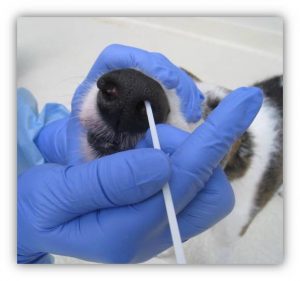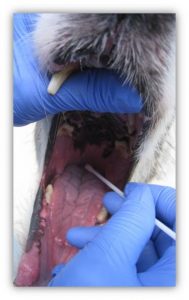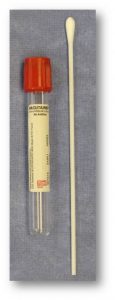Module 4: Healthcare practices for common contagious infectious diseases
Diagnostic Tests for CIRD Pathogens
Since all the respiratory viral and bacterial pathogens cause similar clinical signs, at least during the first week or two of illness, the pathogen causing the infection cannot be diagnosed based on clinical signs!
Not every coughing dog with nasal discharge needs diagnostic testing to determine the cause. However, there are certain triggers signaling the need for diagnostic testing to provide proper management of individual dogs as well as the population. When these triggers occur, timely diagnosis substantially impacts how many dogs remain healthy and adoptable. No diagnosis or late diagnosis increases the number of sick and exposed dogs and the number of dogs that die or are euthanized.
The best diagnostic test is PCR for the pathogen nucleic acid on nasal and pharyngeal swabs. PCR is the most sensitive, specific, and accurate test. The nasal cavity and caudal pharyngeal wall beyond the tongue should be rubbed gently with the swab tip to collect epithelial cells.
- Swabbing the nasal cavity
- Swabbing the caudal pharynx
- Swab materials
At least 2 swabs should be collected from each dog and the tips pooled together in a plain red or white top tube with no additives to maximize the opportunity for pathogen detection. The tube containing the swab tips is submitted to a laboratory such as IDEXX that offers a comprehensive CIRD pathogen PCR panel that tests for the known viral and bacterial pathogens in one sample. The turnaround time for results is usually 2-3 business days which allows for timely patient and population management. The CIRD PCR Panel costs about $125 per sample, but IDEXX offers a substantial discount for shelters.
Although the multi-pathogen PCR panels are very sensitive and specific, PCR cannot reliably differentiate between modified-live vaccine strains and pathogenic field strains for Bordetella, CPiV, CAV2, and CDV. Studies have shown that the modified-live Bordetella and CPiV strains in the intranasal kennel cough vaccine can persist in the nasal cavity for up to 4 weeks postvaccination, causing difficulty in interpretation of positive PCR test results for swabs collected from the nose or oropharynx. Studies have also determined that the modified-live CDV, CAV2, and CPiV vaccine strains given parenterally may be detected by PCR in a small proportion of dogs vaccinated 7-10 days before testing, yielding potentially false positive results. The infection status may be clarified by the dog’s clinical picture, known exposure to dogs with laboratory confirmed infections, and patterns identified through testing of multiple dogs. The best approach is to repeat the PCR test 1 week later: if the PCR is still positive, then the dog is truly infected. If the PCR is negative, then the first result was most likely a false positive.
Test Your Knowledge
- Please disregard references to H3N8 CIV in this practice quiz. This virus has died out and is no longer circulationg in the U.S.




